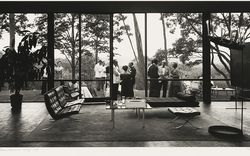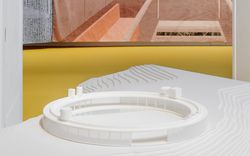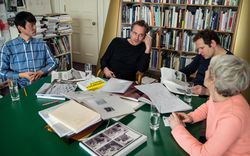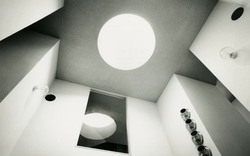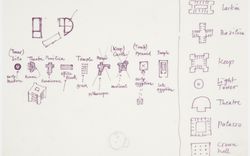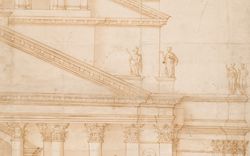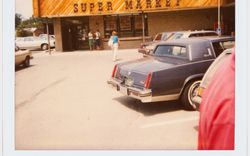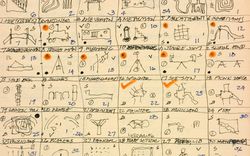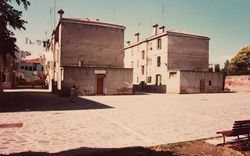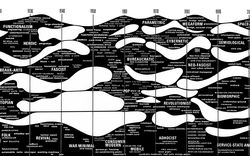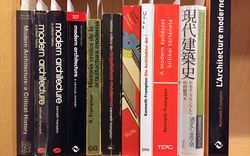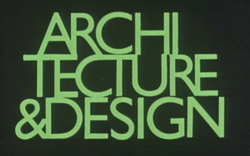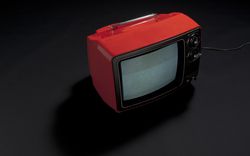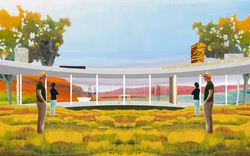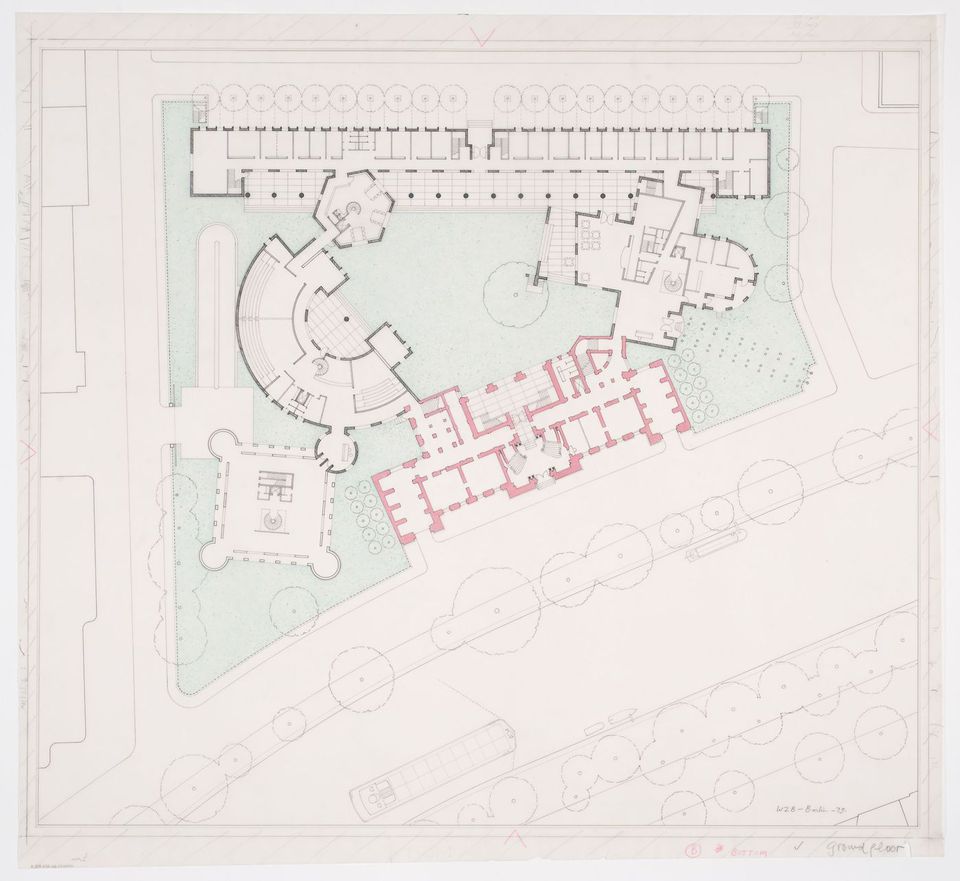“We’ll Have One of Each”
Amanda Reeser Lawrence on James Stirling
Architects tend to keep their references close to the chest. Even the postmodern wunderkind James Stirling, at the height of his freewheeling historicist tendencies in the late 1970s, rarely elaborated on the specific precedents that he deployed in his projects. It’s one thing for an in-the-know architect to recognize the clearly cribbed facade of Le Corbusier’s Weissenhofsiedlung project at Stirling’s Staatsgalerie in Stuttgart (after all, the “original” is just up the hill). But it’s another thing for Stirling himself to admit to, much less elaborate upon, how he riffed off the master. The plagiarist has to stay cagey, clever, and coy.
There are a few instances in his career, however, where Stirling lets us in on the game, where he pulls back the curtain and allows us to see the wizard at work, if only for a moment. Such is the case with a “typological study” for the Wissenschaftszentrum Berlin (WZB), a social science research centre completed in 1989, a decade after James Stirling Michael Wilford and Associates won the IBA-organized design competition.1 Unlike other study drawings for the project—depicting varying site plan configurations, axonometric details, and plan arrangements—this one is unique in its lack of information related to the specifics of the site or project: it is simply a collection of plan diagrams of various historical buildings and building types.
-
Annegret Burg, Josef Paul Kleihues, and Heinrich Klotz, eds., International Building Exhibition Berlin 1987: Examples of a New Architecture (New York, Rizzoli, 1986). ↩
The undated sheet is divided into two parts by a vertical line that sits roughly three-quarters of the way to the right of the page. On the left side are nine plan diagrams arranged in a horizontal row; on the right side, seven plan diagrams in a vertical column. Each of the drawings on the left is accompanied by two terms: a description of an architectural type (ie., “basilica,” “theatre,” “temple”) and the name of an architectural period (ie., “early modern,” “Roman,” “Renaissance”). The slightly larger plan diagrams on the right include five of these historic types (Basilica, Keep, Light Tower, Theatre, Palazzo) and two modern buildings by Frank Lloyd Wright and Mies van der Rohe (“Larkin” and “Crown Hall,” respectively).
In the final design of the WZB, five of these different building types—basilica, amphitheatre, bar, tower, and keep—are loosely arranged together around a central courtyard. Is this drawing the Rosetta Stone that explains the choice of building types? What does it tell us about the way that Stirling thought about history or made use of references? At first glance, the drawing seems to illustrate an almost cavalier use of historical forms, befitting the reigning myth of Stirling as “Vitruvius ludens,” or an architect at play.1 An office employee at the time describes the “working methodology” for the project: “Jim came into the office fresh from holiday at Barfleur, brandishing a little book on the different architectural styles and saying ‘We’ll have one of each.’”2 The office was then asked to “juggle” the different building types while also negotiating an existing building that was to remain on the site.
But this reading elides a more fundamental quality illustrated in the drawing. It’s not simply a cheat sheet or a menu of architectural choices, but the resultant of an exercise in the identification of a set of historical forms and their distillation into generic plan diagrams—in other words, the creation of architectural types. Larkin and Crown Hall disappear in the final design because their specific nature runs counter to the generic quality of the type. Instead of referring to any specific precedent, Stirling’s sketch allows for a comparative plan analysis across architectural history in order to discover general principles behind the given forms, like a more casual version of Jean-Nicolas-Louis Durand’s plates from the Recueil.
Although it seems like this sketch should illuminate the rationale behind Stirling’s choice of building types in the final project, it does not. At least not completely. Two of the nine plan diagrams on the left-hand side of the drawing (“manoir” and “(keep) castle”) are crossed out, yet one of these two (the keep) actually appears in the final project. In the right-hand column, which seems to lead us closer to the eventual building, only three of the final five type-forms appear. The drawing, then, does not indicate a linear progression toward the final design; instead, it represents a thinking through of history. Different plan types are identified and mulled over. They are arranged and rearranged in varied groupings. This non-linear, non-progressive method of testing and retesting is characteristic of Stirling’s work at this time.1
At WZB, Stirling and Wilford adopt, to a point, Colin Rowe and Fred Koetter’s collage method for “conscripting” elements from the past and aggregating them in a planometric formal “collision.”2 While for Rowe and Koetter the heterogeneity of historical fragments served as a critique of utopia and the “total” solution,”3 for Stirling and Wilford collage is an architectural tool rather than a political one. According to Stirling, the “jumble” within the project mirrored the eclectic urban condition around the site, which included the existing nineteenth century Beaux-Arts building on the site, Mies’s Neue Nationalgalerie, and Hans Scharoun’s state library and philharmonic hall. The multiplicity of building forms within the project was also a response to its programmatic variety and an effort to avoid the “banal box-like building” that resulted from the “repetitive” office program, which Stirling saw as the scourge of postwar urban development.4 Though the different plans will eventually be “pasted together” on the site, the drawing illustrates the priority placed on their selection rather than arrangement, and an interest in the type rather than the fragment. In the final plan each building type remains complete and recognizable, and almost entirely unaltered except where it connects to another type. While Stirling’s work has often been described as a compilation of a kit of parts, this drawing reveals that it is better understood as a kit of wholes.
Stirling’s typological study is not the solution to the WZB puzzle. While the final project is undoubtedly an extension of its discoveries, the choice of the five specific buildings is revealed to be inconsequential. They could have been the building types depicted in the sketch but not ultimately “chosen,” or they could have been any other building type within architectural history. A basilica is no more appropriate for a social science office building than a medieval keep or a palazzo. All of history is made available to the architect, but that history is rendered ahistorical.
-
A similar strategy was deployed in Stirling’s Roma Interrotta project. See my essay “The Return of the Dead: Stirling’s Self-Revision at Roma Interrotta,” Log 22 (Spring/Summer 2011): 22–31. ↩
-
In his RIBA Gold Medal acceptance speech of 1980, just after winning the WZB competition, Stirling made explicit his debt to Rowe, “my good friend then as now,” stating that his latest projects were “a collage of old and new elements.” James Stirling, “Acceptance of the Royal Gold Medal in Architecture 1980,” Architectural Design 7/8 (1980): 6. Wilford wrote of WZB: “We used collage and ‘pasted together’ pieces of architecture to make up a plan…elements of the project are accommodated in familiar building forms or fragments.” Michael Wilford, “Introduction,” James Stirling, Michael Wilford and Associates (New York: Thames and Hudson, 1994), 4. ↩
-
Colin Rowe and Fred Koetter, Collage City (Cambridge, Mass.: MIT Press, 1978), 89. ↩
-
“Science Centre for Social Studies, Berlin, West Germany, 1980/1984-88,” GA Document (1990): 80–81. ↩
Amanda Reeser Lawrence is the author of James Stirling: Revisionary Modernist (2012). The CCA holds 617 drawings from the Wissenschaftszentrum project as part of the James Stirling/Michael Wilford fonds.
